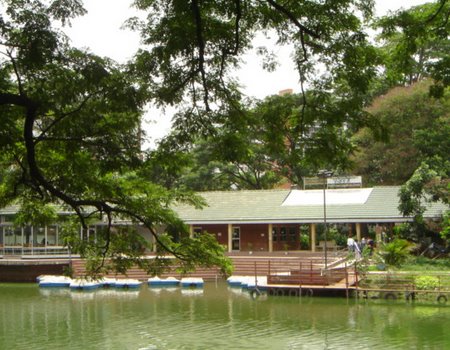“The hands want to see, the eyes want to caress”
- Johann Wolfgang von Goethe
As I started walking down the pathway of Dhanmondi Lake, I was no longer an isolated being, I could see, I could hear, I could touch and smell with a sensation of living every second of a phenomenon, a poetry that enveloped me. The trees with its fresh rustling leaves and the birds chirping on its edge, and the wet grass that I pressed beneath my feet all seemed to speak in unison to the ripples of the lake. Even the twirling branches lowered down upon the lake as if to join hands and celebrate the unique landscape, the architecture, and breathe a sense of relief that the city forgot to lend them. It was a celebration, a heavenly connection of the blue sky, the cosmos up above and the green earth below. Dhanmondi Lake has proven to be an exemplary exception as a landscape architecture where I can come and experience my being in the world. It has, nevertheless, proven to be a significant issue in a contemporary city, which is increasingly a city of the eye, detached from the body by rapid motorized movement.
 (Photo credit: Author) (Photo credit: Author)
A rendezvous with Architect Iqbal Habib brought light upon the various issues of Dhanmodi Lake and, of course, a successful landscape architecture project. When Vitti Sthapati Brindo won the national competition for Bangabandhu Museum, restoration of
Dhanmondi Lake became an extended part of the project, and also sowed seeds of dream in the hearts of the architects!
The potentiality for a self-sustainable project was extreme and they believed in turning the water body into a reconstructed water front for the city, a city that has developed over the ages from the river-branches and khal and the innumerable water fronts.
With eyes slightly protruding, and fixed glitteringly on some point far and beyond, Mr. Habib recalled and shared the moments of truth that we have lost Buriganga and its grandeur when we started to walk away from it, leaving only trails of dismay for the next generations.
Seriously… how much has the new generation seen of the Buriganga?
When Vitti started studying and researching on Dhanmondi Lake and its surroundings, they found that there was not many buildings…just a few two-storied ones…and higher buildings were on its way, but they all tended to show their backs to the Dhanmondi lake and the phenomenon kept rising … Dhanmondi Lake became a garbage being an outcast for long…in ’96, people were killed and their bodies were left in the lake at God’s mercy; it was an apparent den of drug addicts and prostitutes, an absolute reverse to a time when it was a great linked body with beautiful water networking where the ever so charming boats of Bengal used to row back and forth… and the city like a turtle’s pit used to drain out all the water from the top during flash floods … everything was natural. There were numerous jheel and khal binding the present periphery of Dhaka city; interestingly, even the names of hatirjheel or motijheel originated from the very fact that the places were actually a jheel or small networking water bodies!
Mesmerizing as it may sound today, this lake front in Dhanmondi was a platform for mundi or bazaar of dhaan (crops), all of which used to be sailed across by man from the branches of Meghna, from Lakkha river, Begunbari khal, Hatirjheel, Norai khal, and from the non-existent khals at today’s Panthopath. This was an era running way back in the 70’s. Sadly all these connected water bodies are now totally destroyed, so the architects felt the need to restore anything that was left of the truncated water body within their limits of a 98 acre land of the Dhanmondi Lake area. Vitti and its team, with much sensibility, decided to rescue the lake from the clutches of being a dump yard; they decided to save it from encroachment and pollution. In order to do so, various functions were incorporated to ensure the purpose and at the same time, the lake can keep itself clear in its own way and in its own terms … so the design team started using all the potential entities - the water of the lake, the green grass and the trees along the bank, the earth, and moved on to an approach of ‘Less is More’.
“…and the first and foremost step for us was to merge the two divided segments into one integrated body with the help of foot-over bridges or any other bridge, eventually making the neighborhood a unified totality,” says Architect Iqbal Habib, and recollects his journey in the making of Dhanmondi Lake as we see it today.
The program according to the architects’ plan was divided into 3 parts - lake stewardship, lake restoration and lake management. In order for stewardship to take place, certain agendas were pondered upon in order to create a connection between man and the water, agendas such as taking back the land which was continually encroached upon, stopping the pollution into this lake and, of course, bringing in certain design elements into the lake front and in the buildings around. At the end of a day, any man with conscience and integrity will feel that he or she is a part of the place, of the lake, of the nature. So, the design team manipulated a simple element into this commotion as a solution: the use of a “foot-path or a walkway”. It was a deliberate attempt at pushing back all probable and possible encroachment onto the lake’s land by laying this pathway along the edge all the way.
Iqbal Habib, with much content in voice, said that, to his sheer surprise, the people in general who are there to enjoy Dhanmondi Lake became the sole protector of the lake.
The architect marvels at a fine day when a crowd actually admonishes a neighbor to stop dumping wastes on their walkway. It was amazing for him to see that given the accessibility and the ownership, man has undoubtedly taken the responsibility himself to take care of the lake and is participating on his own will to rescue it from any harm. Stewardship was just a budding idea and its outcome for the architects and us, of course, was an education in its own right.
And my faith towards simplicity, simple ideas climbed several steps up listening to a man, an experienced architect here who at the beginning might simply have believed that he could make a wonder, a change!
There were those golden times when cultural ashors or programs used to take place in Mohollas of the then small towns of Comilla, Mymensingh, Rajshahi, Naogaon or even Dhaka. It never really required much flamboyance; all it needed was a small court in a family house and with much ease and levity it became an ashor or jam session of songs, drama, and poem recitals. Hence the very thought-provoking idea of restoring the ideals of the past by an amphitheatre along the lake came in to regain a gradually diminishing culture of the nostalgic ages. The architect’s wistful sketches went on to design a boat house, public toilets, a few coffee shops here and there and small kiosks scattered all along for people to take shelter or to just sit and capture in a breath the subtle and serene edge of mother nature.
““Last but not the least, we took a further holistic approach by developing a unique management system for a “self-sustainable project”. It’s so strange how with the advent of every political leader, public area development projects done in the era of the earlier leaders always go overlooked and eventually into ruins, and there goes the fruits of an architect’s dream and hard work. In order to avoid such mishaps, we developed a management and an advisory committee who will ensure the lake’s maintenance and security with the income that is generated from the coffee shops and boat houses. A law was legalized that money generated will only be recycled back into the welfare of Dhanmondi Lake.”
With an air of revelation, Mr. Habib adds on, “We finally felt that we have done our part, performed our responsibility. To be very frank, architectural consultancy does not include the stewardship and the management. We were only employed for the restoration of Dhanmondi Lake. But we hoped that this will generate more such projects. Unfortunately it did not for a long time until the Hatir Jheel Begunbari Khal project.”
Architect Iqbal Habib is an architect, activist and environmentalist involved in various issues of environment and urban planning apart from his profession for over 10 years now. With much optimism, I think that we will again watch in wonder an idea revitalizing the feelings of water fronts in a city along with its traffic corridors.
And his words continue,
“Every architect must have a political commitment in his or her work. It may sound absurd in an age when politics has taken a nasty position in our society. But, in pure and conscious terms, politics is about serving the people, and eventually the whole world. Every architectural project is an opportunity for you and for all of us to do something for the city as well as the people of this country. It is an opportunity, a blessing from Almighty Allah that I, being an architect can serve people, nature, and with a holistic phenomenological understanding can perform the responsibilities. Every planner in this town must not ignore the fact that they have been taught by the price of billions of people, and they should feel blessed to be able to dream and to be a part of the activity they are into.”
Well … Man is definitely again dreaming; the architects are again contemplating with much pleasure on the integration of mankind with nature, as is the phenomena of Dhanmondi Lake, a true mating of the eyes of the skin with nature!
|
 Reply to this
Reply to this Reply to this
Reply to this Reply to this
Reply to this Reply to this
Reply to this Reply to this
Reply to this


 (Photo credit: Author)
(Photo credit: Author)